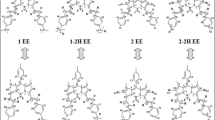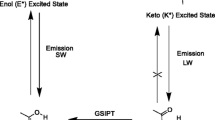Abstract
Density functional theory and time-dependent density functional theory computations were used to understand the electronic and photophysical parameters of NIR β-thiophene-fused BF2-azadipyrromethene dyes. The computed data are in good agreement with those obtained experimentally and they provide insights into the origin of red shifted optical spectra compared to the parent aza-BODIPY, low Stokes shift, non-linear optical responses and quantitative description of the singlet–triplet energy gap. The resultant decrease in the HOMO − LUMO energy gap is responsible for the red shift. The possible use as non-linear optical materials is supported by large enhancement in the non-linear optical properties. On the basis of vertical triplet energies, their possible potential therapeutic use as a photosensitizer in photodynamic therapy is proposed. The singlet–triplet energetic gaps suggest that the β-thiophene-fused BF2-azadipyrromethene dyes can act as a sensitizer to produce an efficient generation of singlet oxygen. Their optimal use as an efficient singlet fission materials has been proposed on the basis of excitation energies in the ground, lowest singlet and triplet excited states.



Similar content being viewed by others
References
Tasior M, O’shea DF (2010) BF2-chelated tetraarylazadipyrromethenes as NIR fluorochromes. Bioconjug Chem 21:1130–1133. https://doi.org/10.1021/bc100051p
Banuelos J (2016) BODIPY dye, the most versatile fluorophore ever? Chem Rec 16:335–348. https://doi.org/10.1002/tcr.201500238
Sun Z-B, Guo M, Zhao C-H (2016) Synthesis and properties of benzothieno[b]-fused BODIPY dyes. J Org Chem 81:229–237. https://doi.org/10.1021/acs.joc.5b02531
Gawale Y, Adarsh N, Kalva SK et al (2017) Carbazole linked near-infrared aza-BODIPY dyes as triplet sensitizers and photoacoustic contrast agents for deep tissue imaging. Chem A Eur J. https://doi.org/10.1002/chem.201605702
Gorman A, Killoran J, O’Shea C et al (2004) In vitro demonstration of the heavy-atom effect for photodynamic therapy. J Am Chem Soc 126:10619–10631. https://doi.org/10.1021/ja047649e
Adarsh N, Shanmugasundaram M, Avirah RR, Ramaiah D (2012) Aza-BODIPY derivatives: enhanced quantum yields of triplet excited states and the generation of singlet oxygen and their role as facile sustainable photooxygenation catalysts. Chem A Eur J 18:12655–12662. https://doi.org/10.1002/chem.201202438
Adarsh N, Krishnan MS, Ramaiah D (2014) Sensitive naked eye detection of hydrogen sulfide and nitric oxide by aza-BODIPY dyes in aqueous medium. Anal Chem 86:9335 – 9342
Li H, Zhang P, Smaga LP et al (2015) Photoacoustic probes for ratiometric imaging of copper(II). J Am Chem Soc 137:15628–15631. https://doi.org/10.1021/jacs.5b10504
Frenette M, Hatamimoslehabadi M, Bellinger-Buckley S et al (2014) Shining light on the dark side of imaging: excited state absorption enhancement of a Bis-styryl BODIPY photoacoustic contrast agent. J Am Chem Soc 136:15853–15856. https://doi.org/10.1021/ja508600x
Ziessel R, Ulrich G, Harriman A (2007) The chemistry of Bodipy: a new El Dorado for fluorescence tools. New J Chem 31:496–501. https://doi.org/10.1039/b617972j
Luo S, Zhang E, Su Y et al (2011) A review of NIR dyes in cancer targeting and imaging. Biomaterials 32:7127–7138. https://doi.org/10.1016/j.biomaterials.2011.06.024
Li D, Zhang H, Wang Y (2013) Four-coordinate organoboron compounds for organic light-emitting diodes (OLEDs). Chem Soc Rev 42:8416–8433. https://doi.org/10.1039/c3cs60170f
Frenette M, Hatamimoslehabadi M, Bellinger-Buckley S et al (2014) Nonlinear optical properties of multipyrrole dyes. Chem Phys Lett 608:303–307. https://doi.org/10.1016/j.cplett.2014.06.002
Deniz E, Tomasulo M, Cusido J et al (2012) Photoactivatable fluorophores for super-resolution imaging based on oxazine auxochromes. J Phys Chem C 116:6058–6068. https://doi.org/10.1021/jp211796p
Collado D, Vida Y, Najera F, Perez-Inestrosa E (2014) PEGylated aza-BODIPY derivatives as NIR probes for cellular imaging. RSC Adv 4:2306–2309. https://doi.org/10.1039/C3RA46235H
Rudin M, Weissleder R (2003) Molecular imaging in drug discovery and development. Nat Rev Drug Discov 2:123–131. https://doi.org/10.1038/nrd1007
Smith MB, Michl J (2013) Recent advances in singlet fission. Annu Rev Phys Chem 64:361–386. https://doi.org/10.1146/annurev-physchem-040412-110130
Smith M, Michl J (2010) Singlet fission. Chem Rev 110:6891–6936. https://doi.org/10.1021/cr1002613
Wu Y, Cheng C, Jiao L et al (2014) β-Thiophene fused BF2-azadipyrromethenes as near-infrared dyes. Org Lett 16:748–751. https://doi.org/10.1021/ol4034622
Gaussian 09, Revision C.01, Frisch MJ et al (2009) Gaussian, Inc., Wallingford CT
Dooley R, Milfeld K, Guiang C, Pamidighantam S, Allen G (2006) From proposal to production: lessons learned developing the computational chemistry Grid cyberinfrastructure. J Grid Comput 4:195–208. https://doi.org/10.1007/s10723-006-9043-7
Dooley R, Allen G, Pamidighantam S (2005) Computational chemistry grid: Production cyberinfrastructure for computational chemistry. In Proceedings of the 13th Annual Mardi Gras Conference, CCT, Louisiana State University, Baton Rouge, LA, USA, 3–5 February 2005, p 83
Milfeld K, Guiang C, Pamidighantam S, Giuliani J (2005) Proceedings of the 2005 Linux Clusters: The HPC Revolution, Chapel Hill, North Carolina, April 25–28
Laloo JZA, Laloo N, Rhyman L, Ramasami P (2017) ExcelAutomat: a tool for systematic processing of files as applied to quantum chemical calculations. J Comput Aided Mol Des. https://doi.org/10.1007/s10822-017-0031-8
Treutler O, Ahlrichs R (1995) Efficient molecular numerical integration schemes. J Chem Phys 102:346–354. https://doi.org/10.1063/1.469408
Becke AD (1993) Density-functional thermochemistry. III. The role of exact exchange. J Chem Phys 98:5648–5652. https://doi.org/10.1063/1.464913
Lee C, Yang W, Parr RG (1988) Development of the Colle-Salvetti correlation-energy formula into a functional of the electron density. Phys Rev B 37:785–789. https://doi.org/10.1103/PhysRevB.37.785
Tomasi J, Mennucci B, Cammi R (2005) Quantum mechanical continuum solvation models. Chem Rev 105:2999–3093. https://doi.org/10.1021/cr9904009
Bauernschmitt R, Ahlrichs R (1996) Treatment of electronic excitations within the adiabatic approximation of time dependent density functional theory. Chem Phys Lett 256:454–464
Hehre WJ, Radom L, Schleyer PvR, Pople JA (1986) Ab initio molecular orbital theory. Wiley-Interscience, New York
Furche F, Rappoport D (2005) Density functional methods for excited states: equilibrium structure and electronic spectra. Theor Comput Chem 16:93–128. https://doi.org/10.1016/S1380-7323(05)80020-2
Yanai T, Tew DP, Handy NC (2004) A new hybrid exchange-correlation functional using the Coulomb-attenuating method (CAM-B3LYP). Chem Phys Lett 393:51–57. https://doi.org/10.1016/j.cplett.2004.06.011
Pandey L, Doiron C, Sears JS, Bredas J-L (2012) Lowest excited states and optical absorption spectra of donor–acceptor copolymers for organic photovoltaics: a new picture emerging from tuned long-range corrected density functionals. Phys Chem Chem Phys 14:14243–14248. https://doi.org/10.1039/c2cp41724c
Cohen AJ, Mori-Sánchez P, Yang W (2012) Challenges for density functional theory. Chem Rev 112:289–320. https://doi.org/10.1021/cr200107z
Johnson LE, Dalton LR, Robinson BH (2014) Optimizing calculations of electronic excitations and relative hyperpolarizabilities of electrooptic chromophores. Acc Chem Res 47:3258–3265. https://doi.org/10.1021/ar5000727
Lanke SK, Sekar N (2016) Coumarin push-pull NLOphores with red emission: solvatochromic and theoretical approach. J Fluoresc 26:949–962. https://doi.org/10.1007/s10895-016-1783-6
Thorat KG, Kamble P, Mallah R, Ray AK, Sekar N (2015) Congeners of pyrromethene-567 dye: perspectives from synthesis, photophysics, photostability, laser, and TD-DFT theory. J Org Chem 80:6152–6164
Ulrich G, Barsella A, Boeglin A et al (2014) BODIPY-bridged push-pull chromophores for nonlinear optical applications. ChemPhysChem 15:2693–2700. https://doi.org/10.1002/cphc.201402123
Zhu M, Jiang L, Yuan M, Liu X, Ouyang C, Zheng H, Yin X, Zuo Z, Liu H, Li Y (2008) Efficient tuning nonlinear optical properties: synthesis and characterization of a series of novel poly(aryleneethynylene)s co-containing BODIPY. J Polym Sci Part A Polym Chem 46:7401–7410. https://doi.org/10.1002/pola
Thakare SS, Sreenath MC, Chitrambalam S et al (2017) Non-linear optical study of BODIPY-benzimidazole conjugate by solvatochromic, Z-scan and theoretical methods. Opt Mater 64:453–460. https://doi.org/10.1016/j.optmat.2017.01.020
Wang J-N, Jin J-L, Geng Y et al (2012) An accurate and efficient method to predict the electronic excitation energies of BODIPY fluorescent dyes. J Comput Chem 34:566–575. https://doi.org/10.1002/jcc.23168
Shi WJ, Lo PC, Singh A et al (2012) Synthesis and second-order nonlinear optical properties of push-pull BODIPY derivatives. Tetrahedron 68:8712–8718. https://doi.org/10.1016/j.tet.2012.08.033
Maroulis G (2007) On the bond-length dependence of the static electric polarizability and hyperpolarizability of F2. Chem Phys Lett 442:265–269. https://doi.org/10.1016/j.cplett.2007.06.024
Maroulis G (1994) Electric dipole hyperpolarizability and quadrupole polarizability of methane from finite-field coupled cluster and fourth-order many-body perturbation theory calculations. Chem Phys Lett 226:420–426. https://doi.org/10.1016/0009-2614(94)00719-5
Maroulis G (1996) Electric properties of carbon tetrafluoride. Chem Phys Lett 259:654–660. https://doi.org/10.1016/0009-2614(96)00728-2
Maroulis G (2003) Electric (hyper)polarizability derivatives for the symmetric stretching of carbon dioxide. Chem Phys 291:81–95. https://doi.org/10.1016/S0301-0104(03)00186-1
Maroulis G (2003) Ab initio determination of the electric multipole moments and static (hyper)polarizability of HCCX, X = F, Cl, Br, and I. J Comput Chem 24:443–452. https://doi.org/10.1002/jcc.10239
Maroulis G, Xenides D, Hohm U, Loose A (2001) Dipole, dipole-quadrupole, and dipole-octopole polarizability of adamantane, C10H16, from refractive index measurements, depolarized collision-induced light scattering, conventional ab initio and density functional theory calculations. J Chem Phys 115:7957–7967. https://doi.org/10.1063/1.1410392
Karamanis P, Maroulis G (2011) An ab initio study of CX3-substitution (X = H, F, Cl, Br, I) effects on the static electric polarizability and hyperpolarizability of diacetylene. J Phys Org Chem 24:588–599. https://doi.org/10.1002/poc.1797
Quartarolo AD, Russo N, Sicilia E (2006) Structures and electronic absorption spectra of a recently synthesised class of photodynamic therapy agents. Chem A Eur J 12:6797–6803. https://doi.org/10.1002/chem.200501636
Mazzone G, Quartarolo AD, Russo N (2016) PDT-correlated photophysical properties of thienopyrrole BODIPY derivatives. Theoretical insights. Dye Pigm 130:9–15. https://doi.org/10.1016/j.dyepig.2016.02.021
Karlsson JKG, Harriman A (2016) Origin of the red-shifted optical spectra recorded for aza-BODIPY dyes. J Phys Chem A 120:2537–2546. https://doi.org/10.1021/acs.jpca.6b01278
Acknowledgements
The authors Y. G. and N. S. greatly thankful to University Grant Commission-SAP, New Delhi, India for providing financial support.
Author information
Authors and Affiliations
Corresponding authors
Electronic supplementary material
Below is the link to the electronic supplementary material.
Rights and permissions
About this article
Cite this article
Gawale, Y., Rhyman, L., Elzagheid, M.I. et al. Excited State and Non-linear Optical Properties of NIR Absorbing β-Thiophene-Fused BF2-Azadipyrromethene Dyes—Computational Investigation. J Fluoresc 28, 243–250 (2018). https://doi.org/10.1007/s10895-017-2186-z
Received:
Accepted:
Published:
Issue Date:
DOI: https://doi.org/10.1007/s10895-017-2186-z




